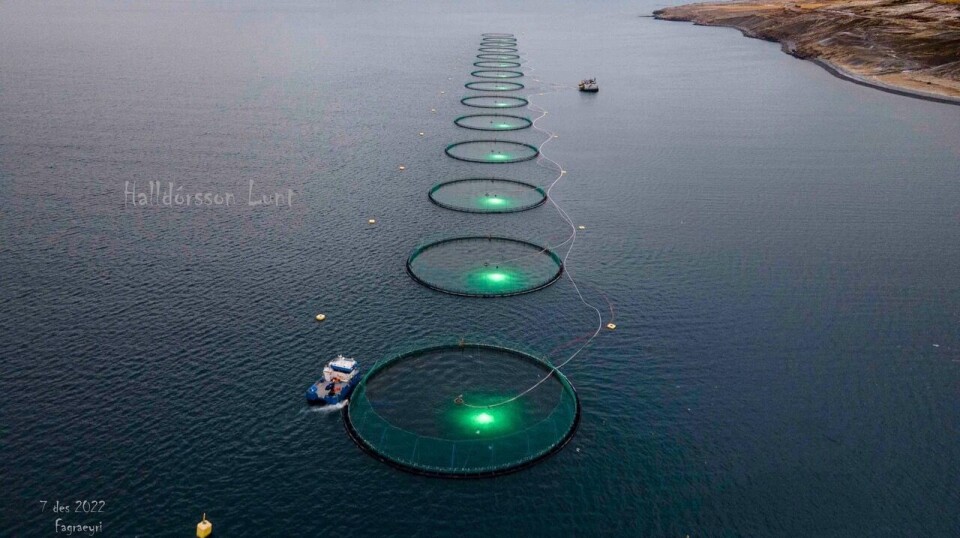
How technology is taking Ice Fish Farm forward
Sampling buoys, oxygen boosters, and lighting from Norway are crucial to progress at exposed, cold sites
Salmon farming is not a one-size-fits-all business and in Iceland, where the aquaculture industry is still at a relatively early stage, the operation of the fish farms must be adapted to the seasons and weather conditions. Technology plays a key role in handling the environment.
Unlike in Norway, there are not many deep fjord systems. The west coast of Iceland has temperate conditions while the east coast has a colder climate. Both regions are exposed to wind and waves.
“Iceland itself works as a barrier for the southern ocean currents and thus the east coast is colder. That’s maybe the reason for the negligible parasite problems on the east coast. This means good conditions for fish farming, however, it is not straightforward,” says Kjartan Lindbøl, production manager at Ice Fish Farm, a company running seven fish farms at four different sites.
Five years in Iceland
Lindbøl grew up on Senja in Northern Norway and has many years of experience in aquaculture. He has worked in Iceland for five years and expects growth in farming for the years to come. Ice Fish Farm is partly owned by the Norwegian company Måsøval that is involved in several Icelandic fish farms. The main market is the United States, where Icelandic fish products have a high reputation for being produced a clean marine environment.
“Norwegian aquaculture technology, competence and financial resources play a key role for the development of the industry,” says Lindbøl, who highlights the good water quality but also indicates that the site conditions may vary.
“You must relate to more complex ocean currents and there are more wild fish stocks in the fjords. During winter stormy weather and cold periods occur, while the temperature in autumn is optimal for salmon growth.”
Temperature data
At present, Ice Fish Farm is being upscaled. Temperature data are vital for the operation, not least to optimise feeding. Reliable environmental monitoring is essential, and Norwegian wireless sampling buoys sampling temperature, oxygen and salinity are frequently used.
“During special weather conditions the oxygen concentration may drop. We are now testing out solutions to improving the water circulation in the cages,” explains Lindbøl. “During the last decade the climate on the east coast has changed, with increasing temperature, which is positive for fish farming. The fjords used to be ice covered. More rain gives more freshwater in the fjords. We master local conditions by good planning based on logging data from wireless buoys.”
Another phenomenon, also commonly experienced in Scotland, is episodic jellyfish blooms. Jellyfish can clog the nets and limit water exchange. To ensure good oxygen supply for the fish, the oxygen concentration is monitored inside the pens.
“To ensure good production progress we are now supplying oxygen by lifting deepwater into the cages. These solutions, Turbolift among others, are based on a collaboration with Bio Marine in Surnadal, Norway. Backup by an experienced partner is vital for us introducing such technology in commercial scale cages,” says Lindbøl.

Lighting to control sexual maturation in salmon cages is already an established routine in Iceland. It is mandatory to use lights.
“There are rules for the use of light in fish farms. The light must be put out at sea according to particular dates. We use one array per cage, a solution that has strongly improved the operation,” says Lindbøl, who considers Iceland a young aquaculture nation with a great potential.
“The guidelines here are somewhat different from Norwegian guidelines, and maybe not correspondingly developed. However, with Norwegian interests and technology involved we can make higher demands than the authorities and we take the environment highly serious on this beautiful island.
“In our opinion, Bio Marine is a progressive company that wants to join the team to facilitate a more stable and predictable production here in Iceland. Flexibility and deliverability make Bio Marine our preferred partner on the east coast of Iceland.”























































